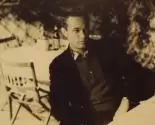The Passing of a Legend

I cannot say that I accidentally wandered into Don Magner’s Arts and Crafts antique shop in the SoHo district of Manhattan that fall day in 1987, for I had carried his Lafayette Street address in my wallet along with me from my home in North Carolina.
I was a neophyte, and Don Magner was a god. While he would never claim so himself, many believed Don Magner had initiated the Arts and Crafts revival in New York City. Unlike those who receive credit for the revival, Don was not drawn to the Arts and Crafts style as an academic, for he was first — and always — an artist.
While Don Magner was often the subject of reporters’ interviews, I cannot recall Don ever writing a book or even an article on the Arts and Crafts movement. Not that he couldn’t have.
After graduating from college during the early Eisenhower years, Don began his diverse career as an artist, actor and screenwriter in New York City. Talented, slim and as handsome as a Calvin Klein model, he was drawn to the New York literary crowd. Tennessee Williams took the young writer under wing, often bringing Don along with him to his Key West home. Don worked on movies with actress Vanessa Redgrave, director Tony Richardson, and actor Orson Wells, counted Noel Coward and Jeanne Moreau among his friends, and developed a following for his own original artwork.
And it was Don’s eye for design and his intuitive sense of artistry that soon spotted overlooked examples of Gustav Stickley and Charles Rohlfs furniture languishing in antiques shops and East Coast homes. In the 1960s he opened the first of his shops and began doing antiques shows, selling a mixture of Art Deco, Art Nouveau and Arts and Crafts. A favorable 1975 New York Times endorsement of his shop and of the growing popularity of the Arts and Crafts style soon brought new collectors and celebrities to his Brooklyn warehouse, where he had accumulated a sizeable collection of Roycroft, Stickley, and Rohlfs furniture.
Soon, however, a number of upscale shops dedicated to the Arts and Crafts style began opening in SoHo, including the Jordan-Volpe Gallery, Peter-Roberts Antiques, Richard Caggiano, Michael Carey and Gallery 532, many of whom filled their showrooms with pieces fresh from Don’s Brooklyn warehouse. In order to compete with them, Don — somewhat reluctantly — opened a gallery in the antiques district of the city in 1982.
And so, in 1987 when I came to New York with a plan to start an Arts and Crafts Conference in a little-known 1913 hotel in Asheville, North Carolina, I went to introduce myself to Don Magner. I knew I had little chance of convincing him to make the 700-mile journey to an unknown show put together by an untested organizer, for Don, like the other Arts and Crafts galleries, was accustomed to doing the highly-acclaimed Manhattan Pier Shows and the famed Modernism Show.
But on that cool fall day on Lafayette Street, Don Magner rose out from behind his massive desk and spent more than three hours with this neophyte, patiently taking me around his gallery and showing me, item by item, subtle design details that made each piece special. I made notes, snapped photographs and hung on his every word, recognizing that I was walking beside an artist who could still get excited about a small, essential detail – a graceful corbel or a dramatic arch – and who was just as excited about sharing all that he knew with a budding young collector.
And a few months later, In February of 1988, Don Magner did come to Asheville, where he was among the handful of dealers who took a chance on the inaugural Arts and Crafts Conference at the Grove Park Inn.
After his retirement, I lost contact with Don, who retreated to his Brooklyn apartment, embraced by his collection of favored pieces and his personal artwork until his death a few weeks ago. But I never lost my admiration for Don Magner, nor my appreciation for his encouragement that fall day back in 1987.

Until next Monday,
Thank someone who made a difference in your life.
Bruce
Note: If you are interested in learning more about Don Magner and the early years of the Arts and Crafts revival, be sure to get a copy of Redux: The Arts & Crafts Revival, 1972-2012, researched and written by Judith Budwig and Jeffrey Preston. It’s a book you won’t want to put down. Available on Amazon.
Photos from Redux provided by Jeffrey Preston and Judith Budwig. Top: Don in his Brooklyn apartment; Center: A younger Don in Europe while on location for a movie.
